AURAL HAB AX
1/35
There's no tags or description
Looks like no tags are added yet.
Name | Mastery | Learn | Test | Matching | Spaced |
|---|
No study sessions yet.
36 Terms
Assessment of listening skills
In the context of Diagnostic therapy
When dealing with children with HL in aural habilitation, we continuously assess.
One of the areas we assess is listening skills
Focus on assessing listening skills while doing therapy through questionnaires, models, checklists and the likes.
getting to know the child and the family
Evaluation is _____?
Even if it's in the context diagnostic, this is still diagnostic.
The sole purpose: GET TO KNOW THE CHILD in terms of their strengths, interests in terms of what makes them listen more, participate in sessions, baseline skills, what they need to learn.
What makes Aural Hab unique is that we firmly stress family participation.
Realize that we really need to teach the family (esp. in AVT)
Getting to know what the parents know and their skill sets could help us in setting expectations for parent coaching and plan out how to coach and guide the parents along with the whole family.
Process of using assessment tools/strategies to arrive at a diagnosis
Evaluation is the _____?
During diagnostic therapy, we don't usually diagnose. We plot the skills.
During the therapy sessions, [we note] at what level the patient current functioning or what listening skills does the patient actually exhibit? Is that typical for their age?
This will guide us in what to target next and curate the entire long term plan.
An ongoing process
Evaluation is _____?
Ongoing process esp. in aural habilitation for children.
Knowledge of norms, Knowledge of testing strategies, Observational skills, Empathy, Scrutinising all aspects of behavior
Evaluation requires (6)
No need to memorize but have to know the key points in terms of listening; e.g. When detection starts, identification starts.
We all have good share of experience with patients requiring strategies in order to have the child participate in certain tasks and tests
Most important: very good observational skills
In CLASP, they usually record sessions in video to see if they are doing it correctly in terms of also looking at the skills of the patient.
This is something that is developed over time.
At least when you go back to your videos (us), we should be able to pinpoint the skills, identify difficulties, and how to plot it well in the checklist and curriculums.
Speech and Language is not black and white that you touch and manipulate. Hence, it requires some level of inferencing. We won't be imagining skills out of the blue. But if the child was able to perform a certain skill, then most likely they could also do the pre-requisite skill.
Know how to put yourself in our patient's shoes since it's knowing the families and the child. If we could place ourselves in their shoes, we could know them better.
Although we are not behaviour specialists, it refers to the behavior exhibited by the patient.
Developmental model, Auditory processing model, Combined model
The assessment of auditory skills or listening skills are grouped into models
3 Models are…?
Developmental model
The word developmental it could be inferred that this is based on development
This is an assessment where you would ask yourself “At what age is my patient performing at?”
Because you are going to compare the skills that you observe in the sessions to the skills that are normally exhibited by a certain age level
Based on ages and stages of typical development of listening and spoken language comprehension
Often applied for use with children who are ideal aural habilitation candidates
Those who are fitted early, identified early, and intervened early
These are the patients who don’t usually fall far from the chronological age
This is applicable to the children who are still in the trajectory of normal development
You can compare it to those with delays only, rather than disorders
Developmental model strategy 1
You have to be familiar with typical auditory development and receptive language benchmarks
The end goal of the hierarchy listening function is the development of comprehension
There are a lot of checklists and references that interchange listening and receptive language
Can be seen for example in PLS, the earlier skill listed in auditory comprehension are some form of listening skills
You cannot do the developmental auditory assessment if you do not have an idea of typical auditory development and receptive language benchmarks
It is very hard to memorize, so we are thankful to AVTs who have developed the scales that we know of and the different milestones that we can use in assessment.
Doreen Pollack’s hearing and speech scale
Doreen Pollack is one of the one who published the development of listening function where she divided it into 3
First 3 months
Second 3 Months
Third 3 Months
Basically you observe the patient and tick the skills that you have observed
You can see that the skills are arranged according to ages
If most of the ticks fall under the first 3 months category, most likely the patient is performing at that level
The next goals will be the remaining skills in that bracket or the ones in the next bracket
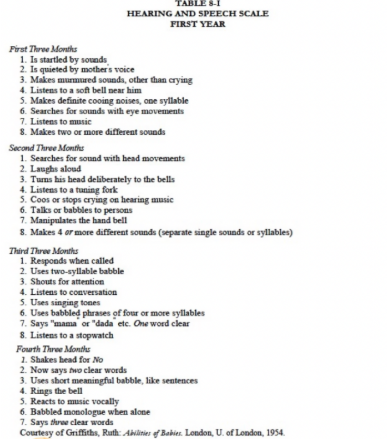
Hierarchy of Early Auditory Responses (HEAR) Chart
This is developed by the DHSS
An institution that caters to children who are deaf and hard of hearing
This describes the benchmarks in listening behaviors of typically developing children from birth to 18 months
If your hearing age falls within that range then you can use this
Similar to how you mark a bloom and lahey grid
You check it across categories and those with complete marks are checked in that range then that is the level that child is performing at.
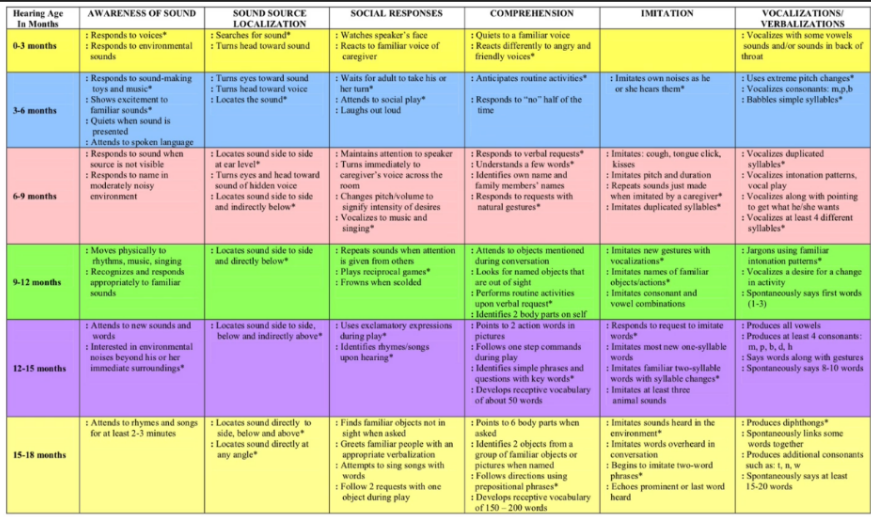
Auditory Language Comprehension (ALC) Benchmarks
Based on various curricula and developed by Morrison.
This tool allows you to observe the patient and tick off the skills you have observed.
You can also elicit some of the skills that haven't been demonstrated.
This helps you determine the child's current age level and identify the next goals to target.
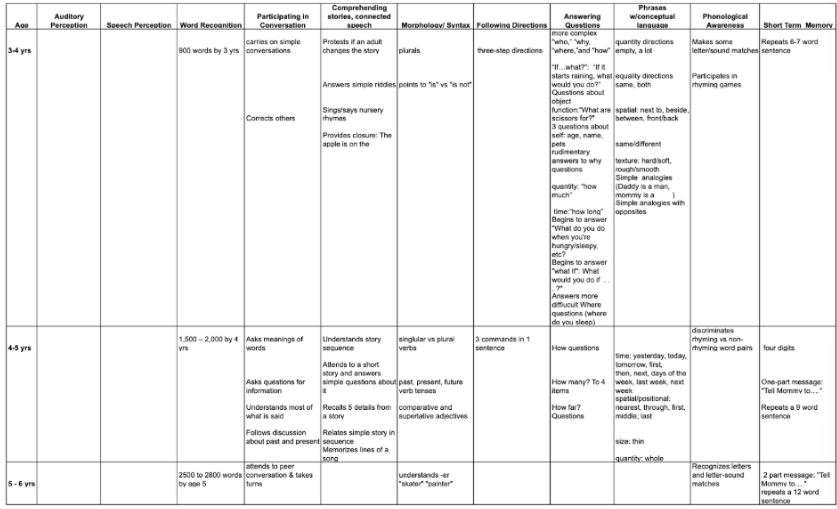
Integrated Scales of Development
Developed by Cochlear Corporation, this tool allows you to simply tick off the skills that are present.
If 70% of the skills in one section are ticked, that is considered the mastered level.
This is made for children from birth to 4 years of age across different domains including social communication and cognition, not just listening.
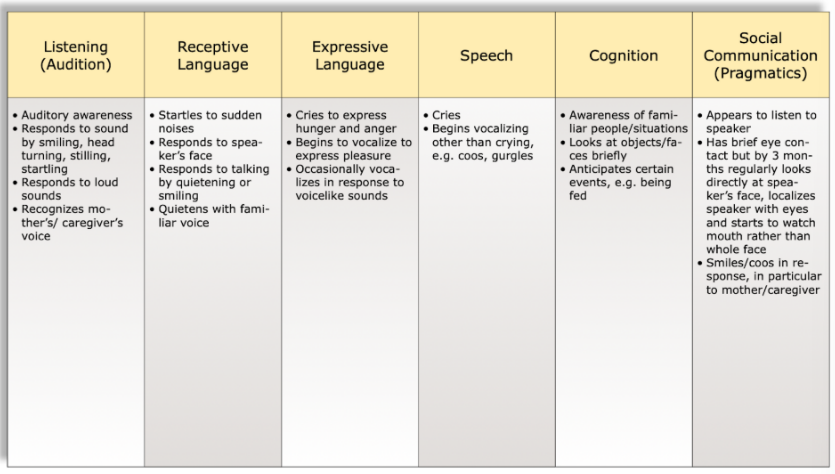
Developmental model strategy 2
Use informal checklists and questionnaires that compare a child’s listening skills to typically developing peers
There are numerous checklists and questionnaires available, and you can use one or a combination of them.
Some questionnaires may differ in administration and tend to have different coverage.
Is the child an infant or preschooler?
Will give you an idea for the age.
For example, this questionnaire is only meant for this age. It can help you choose.
Is an informal checklist with a parent's report a better way to obtain information than formal testing?
If the answer is yes, then you should use a checklist.
Unlike other cases, we usually start with children with HL very young. We could start therapy even at six months of age.
This is why we rely on parent reports early on.
It is very difficult to elicit skills below 1 year old even so at 2 years old it is still difficult. We utilize many evidence-based questionnaires for parents that require a parent report.
Do you wish to supplement formal testing with observation and parent report?
Do you want to be able to compare the child’s performance with typically developing children?
Not all questionnaires are meant to compare to typically developing children.
Is it important to you that there be statistically valid normative data for comparison?
Essentially the questionnaire that you will be using should be:
Appropriate for the child’s age
Yield the kinds of scores that you need
Assesses the listening behaviors and RL aspects that you want
It should be valid.
LittleEars Auditory Questionnaire (LEAQ)
By Med-El, one of the providers of CI in the Philippines
A questionnaire that is self-administered by the parents.
Comes in English and has a Tagalog version as well.
How to complete?
All questions are to be answered by checking either YES or NO.
YES: If you have already observed the behavior in your child at least once.
NO: If you have never observed the behavior in your child, or if you are not sure how to answer the question.
If you answer 6 questions with “NO” for children with normal hearing, you do not need to continue the questionnaire.
Further questions will then be regarded as “NO” answers.
For children with CI(s) or HA(s), all questions should be answered, since they may show auditory behavior covered by later questions.
Sample:
You will calculate it at the end.
How many yes and how many nos were answered.
Then you will come up with the score.
The score will be plotted on the score sheet.
Scoring:
For example, during the assessment the child scored 2 and the hearing age is at 20 months then you plot it there. (↑)
If the dot is within the graph ( line), then it is considered to be typical.
Track a Listening Child
Developed by Cochlear: Cheryl Dickson and Nancy Calleffe Schenck
Another cochlear implant company that is available in the Philippines
A companion for the Integrated Skills of Development
There are some similarities
Audition and receptive language are sometimes joint together or interchanged
You just have to check the skills present
Areas you need in order to plan sessions for these patients:
Audition/Receptive Language
Expressive Language
Speech
Pragmatics
Cognition
Just tick and you would know where the patient is actually performing at and what next skill to target
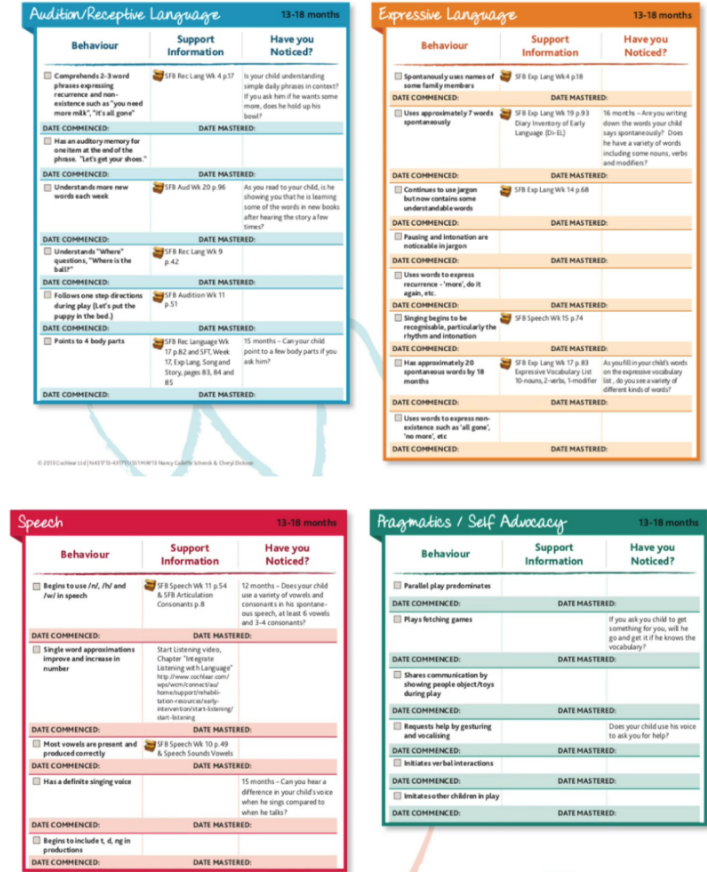
Developmental model strategy 3
Use standardized assessments that are normed with typically-developing children
global assessments of RL
specific assessments of RL
global assessments about specific language domains
Developmental model strategy 4
Use the child’s chronological age and hearing age to interpret performance
You have to know how to interpret the skills you observed and plotted on the different checklists
You interpret it by comparing the skills to the child’s chronological age and hearing age
Hearing age: The date at which the child begins to learn to listen
The child’s hearing birthday
You might want to consider this date as the date at which a child is wearing his hearing aid or other technology full-time
Should be hearing aids or technology that are appropriate
The length of time that the child has been listening with this technology full-time is the child’s hearing age
Ex. A child who is 4 years old who has been listening full-time with an appropriate hearing aid since 18 months, has a chronological age of 4 years but a hearing age of 2.5 years
How to determine
Record Review: Determine when a child achieved full-time use of hearing technology
Calculate an estimation of hearing age
Look at behaviours expected for your child’s HA and CA
Administer a developmental checklist
Administer a standardized test
Sometimes it’s hard to calculate for the hearing age because you wouldn’t know when was the full-time use or if it is the appropriate hearing aids
Have an alternate hearing age
Consider the age fitted in the calculation
Indicate that it is calculated in the premise that you don’t know when is the full-time use of the technology
Others say that the hearing age and CI age are different
Up to you on what you want to use
Essentially, if the child is wearing hearing aids and they are not benefitting, it’s not good to calculate for the hearing age during that time
Auditory Processing Model
Also known as Model of Auditory Assessment which is more remedial
Also hierarchical, orderly, and sequential, but the skills and sequences are guided by how listeners process a signal to comprehend it
Based on characteristics of the spoken language stimulus and hierarchy of responses that listeners can make to that stimulus
Based on Erber’s hierarchy of auditory skills
Frequently described as a remedial model
Recommended for children who begin listening later in life
Such children may be substantially delayed in listening and spoken language development
May be transitioning from using dependence on visual cues to using audition as the primary sensory modality
Many assessment and intervention materials that were created for deaf children, prior to the advent of newborn hearing identification and early fitting with technology, utilized an auditory processing model and merit a closer examination when we are considering intervention for today’s children with hearing loss
It is essential to monitor how well a child uses his hearing to ensure that he is developing auditory skills optimally
Auditory skills hierarchies provide framework for breaking down listening into smaller subskills that can be targeted by parents and professionals, and learned by the child
Erber model
Auditory responses cannot take place without stimuli
Erber pointed out that we must pay attention to the stimuli that are presented to a child
Including systematically assessing by stimulus type
He also pointed out that the listener may exhibit different levels of response, depending on the stimulus
He included the following table in his 1982 book
The Erber model suggests that a syllable is a lower level stimulus than the sentence because the syllable is less complex than a sentence
It’s possible, however, to work with the stimulus hierarchy from the opposite direction as well
For example, it may be difficult for a child to recognize the word “fizzy” when presented in isolation, but when it appears in the sentence “fizzy soda pop tickles my nose”, there is a semantic context and syntactic information as well
These multiple cues provide redundancy in the signal and various meanings for the understanding of the word “fizzy”
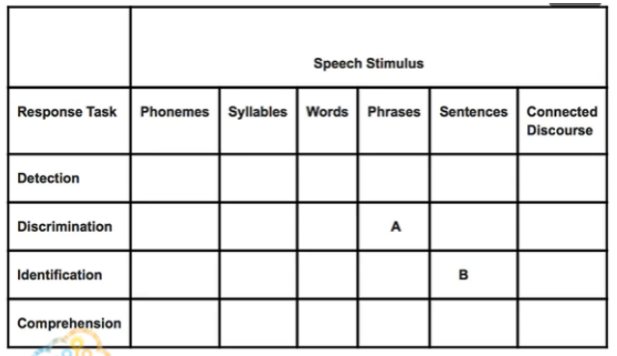
Auditory processing model strategy 1
Assess auditory skill levels
Auditory skills hierarchy has provided a model for assessment and intervention for decades
Prior to universal newborn hearing screening, the development of cochlear implants, and the early fitting with hearing technology, audition was far less likely to develop with other developmental domains
A child’s auditory skills developed more slowly and often required specific teaching that targeted small steps
The Erber hierarchy and others that were based on Erber’s model, enabled us to monitor progress and set specific listening goals
We have not stopped with Erber’s basic hierarchy, you will find expansions of Dr. Erber’s hierarchy to include skills that have been proposed as essential to the comprehension of spoken language
When a child begins understanding sentences, and longer stretches of conversation, including following directions or telling stories, he is utilizing memory and sequencing ability
If a child is making slow progress understanding spoken language, assessment of memory and sequencing may be helpful to identify a difficulty in general cognitive ability or executive functioning beyond the effects of hearing loss
We can go further and consider the auditory skills necessary to make sense and learn from conversation, and verbal instruction
Functional Assessments and Checklists
These checklists employ auditory hierarchy and most closely follow the Erber hierarchy
You will find that as the level of auditory processing increases, there is more specification with regard to the language that is being processed
Integrating receptive language acquisition and auditory comprehension
Parent questionnaires
Caleffe-Schenck and Anderson Auditory Skills Checklists
Functional Auditory Performance Indicators
St. Gabriel’s Checklists
IT-MAIS
Infant-Toddler Meaningful Auditory Integration Scale by Zimmerman-Phillips, Robbins, and Osberger
Adaptation of the meaningful auditory integration scale
Both are parent interviews that were developed as a means of tracking a child’s responses to auditory stimuli pre- and post- cochlear implantation
IT-MAIS is more commonly in use because children typically receive cochlear implants in infancy or toddlerhood today
LEAQ vs IT-MAIS
Both auditory questionnaires meant for parents
LEAQ: self administered questionnaire yes or no questions
IT-MAIS: interview, open-ended questions then write in verbatim what the parent answered then the clinician will rate based on the answer of the parent
10 questions (0-4)
Responses of the parents are actually recorded in verbatim and then later on scored from 0 to 4 by the clinician
0 = never, 1 = rarely, 2 = occasionally, 3 = frequently, 4 = always
3 Main Areas: Vocalization, Alerting to Sound, Deriving Meaning From Sounds
Age Equivalence*
Was derived from a study using the IT-MAIS
Score Sheet used to summarize the responses of the parents
Under the parent report column, the verbatim responses of the parent should be listed there and then later on the score should be encircled per question and then the total score will be computed as well
Cincinnati Auditory Skills Checklist
Auditory Processing Model Parent Questionnaire
questionnaire designed to track a child’s auditory responsiveness over time
The items are classified according to the response levels in the Erber hierarchy:
Detection
Discrimination
Identification
Comprehension
The checklist allows for a more refined look at a child’s progress over time rather than answering yes/no questions
Each question is answered according to this scale:
S (often)
E (sometimes)
D (never/rarely)
Each response receives a different point value
The total points give a measure of the child’s responsiveness
Authors recommend that the assessment be administered every 3 months
Results can be supplemented by observation
The point system assigned to each of the responses are 0,1, or 2
Performance is scored in terms of the total amount of points out of the possible 70 and also by the change in scores over time
Nancy Calleffe-Schenck (1992)
First to create the auditory skills checklist
There are 27 items that each describe an auditory behavior preceding from auditory awareness, detection, and finishing with listening on the telephone and background noise
It should be rated as none, sometimes, often, always
Karen Anderson (2004)
Checklist was re-organized into 10 levels
Response was modified into
Emerging
Inconsistent
Acquired
Functional Auditory Performance Indicators (FAPI)
The profile of the child’s functional auditory skills is generated after administering all the items in the profile
The 7 categories are hierarchical, in addition, auditory performance indicators in each category are listed also in hierarchical order.
Note that while the scale is hierarchical, it is appropriate for the child to be working on the skills at the same time.
Approximately, 4-8 skills can be addressed simultaneously
By working on multiple skills from different categories, the child will be learning an integrated approach to an auditory skill development
Each category has several stimulus probes
The performance on each probe is elicited in 3 presentation conditions:
With visual cues
At close range (within 3 ft.)
At a distance
The child’s response to the probe is scored along the four levels of attainment
Not present
Emerging
In process
Acquired
By dividing the earned scores or the total numbers of possible points, the child receives percentage score for this category
In this example, the earned score is 58 points which is divided by the total possible score of 72 points (58/72)
The child receives a percentage of 80.5 for this category
Once the category score is determined, this score would be filled out in the performance profile:
After shading the appropriate cells that corresponds to the scores, we will note which of the 7 categories are already acquired, in process, emerging, or not present
Sound awareness, Sound is meaningful, Auditory feedback, Localisation, Auditory discrimination, Short term auditory memory, Linguistic auditory processing
Functional Auditory Performance Indicators (FAPI)
Where we look into how the child is aware that an auditory stimulus is present; The child may demonstrate awareness of loud environmental sounds, noisemakers, music, and/or speech
Would test if child can attend to sounds and associate a variety of stimuli with their sound source
Loud environmental sounds, noisemakers, music, vocalizations, and speech stimuli
A child may simply attend to a sound which is relatively easy or the child may match the sound with its sound source which is a more difficult skill
We look into if the child can monitor the sound he/she hears
A child may demonstrate this skill when responding to sound when amplification is turned on, by vocalizing in order to monitor whether amplification is working, and/or by noticing his/her own vocalizations
The child searches for and refines the auditory stimulus. Searching is a prerequisite for localizing. Children with hearing in only one year may not be able to localize to the sound source that is why this is not applicable to them
Looks into how a child distinguishes the different characteristics of different sounds including environmental sounds, suprasegmental characteristics of speech, non true words, and true words
Looks into how the child can hear, remember or repeat and recall a series of numbers. This scale is developmentally appropriate who are 2 years of age or older. Numbers are used in order to isolate the skill which is auditory memory
The child is observed if he/she can utilize auditory information to process language. This category measures the ways in which audition is used to sequence language, learn and use morphemes, to learn and use syntactic information, and to understand spoken language
St. Gabriel’s Checklist
Checklist across multiple developmental domains
Commonly associated with the auditory memory domain
However, it also consists of multiple developmental domains
Most domains: referenced to the age at attainment by typically developing children
In this checklist, each of the item is categorized according to the auditory skills hierarchy
Auditory memory domain: increasing complexity
St. Gabriel’s checklist - strategy 1
Before administering any assessment:
Check equipment to be sure it is working optimally
Conduct Ling 6 sound test to ensure that the child listening at his best
Select tool appropriate to a child’s developmental age
The assessments and checklists described here vary with regard to ages targeted and the thoroughness that age levels are described
We may need to read through an assessment or checklist to determine if it’s appropriate for your child or patient
What skill do you like to assess?
Does the assessment yield information that you could use for planning for this particular child?
Some assess very early awareness and identification skills, while others assess response to scores and some higher listening skills
Is the language level that is assessed appropriate for the child under consideration?
Look over the checklist to get a sense of the stimuli that are assessed
St. Gabriel’s checklist - strategy 2
Assess discrimination/identification
In this context, discrimination and identification is used interchangeably
Discrimination: common task in listening assessments and training curriculum developed for children with hearing loss
To find out what the child was able to hear
What the child was able to hear with hearing technology
To find out whether child is attending to speech auditorily or inordinately dependent on visual cues
Hearing technology may not allow the child to hear all the important differences between speech sounds that separate them as phonemes in the child’s language
We need to know what the child can discriminate easily and what presents a challenge
Discrimination assessment can identify the speech contrasts that require more focus input and practice so that the child can actually perform well
Informal assessment, Picture identification, Syllable identification, Information from audiological speech perception testing, Open set tasks
Tasks that Examine a Child’s Ability to Discriminate and Identify Speech Sounds (5)
Informal assessment
Tasks that Examine a Child’s Ability to Discriminate and Identify Speech Sounds
By noting what the child understands or fails to understand in conversations or in play
Particularly useful for young children
E.g. Parents and professionals can set up the environment and have the child help clean up, naming toys for the child to pick up, and taking note of any confusion that the child might make when identifying toys that an adult names
For example: Asking the child to pick up the car, pick up the bubbles, pick up the ball
In this sense, you’re observing if the child is identifying the words that you are saying through auditory alone
in informal assessment, you could also use some of the information in the checklist to have an idea of whether the child can start discriminating already
in the IT-MAIS, you can see the items/test questions that look into discriminating speakers voice or speech vs. non-speech sounds
in the Cincinnati Auditory Skills Checklist, there are a number of discriminations that are listed there as well
Same goes with the anderson auditory skills checklist
Picture Identification
Tasks that Examine a Child’s Ability to Discriminate and Identify Speech Sounds
Something very familiar to us
This task is used for children who are ready for more structured assessment
A group of pictures or objects are placed before the child, the names of the items differ in speech feature that would be discriminated
For example: in order to evaluate a child’s ability to discriminate vowels, the child can be asked to point a to a specific picture between bed, beede, bad, and bug, the clinician names a picture, and the child selects a picture corresponding to the word that he hears
In order for this task to be valid, the child must know the names of all the objects or pictures before him
It is important therefore to preview the items on an assessment to make sure that it is appropriate for the child
In the case of discrimination testing, it is okay to pre-teach the words on the assessment because you are not testing vocabulary, you are evaluating whether or not a child can hear the differences among words
Syllable identification
Tasks that Examine a Child’s Ability to Discriminate and Identify Speech Sounds
Some assessments have the child select from non-sense syllables that vary in speech feature being evaluated
For example: there might be 4 cards with the syllable printed on each card, cha, ta, sa, and sha
The teacher or the clinician reviews each card with the child or maybe if the child can read, the child can read each card aloud prior to testing to ensure the child understands what is represented in each card, this requires the child to have some reading ability
Information from audiological speech perception testing
Tasks that Examine a Child’s Ability to Discriminate and Identify Speech Sounds
Audiological assessment of speech recognition can yield useful information about the child’s ability to discriminate speech
When speech recognition is assessed, it is assessed audiologically, and when it is assessed audiologically, children repeat words or point to pictures in response to speech delivered at an intensity equivalent to conversational levels
Ordinarily, the audiologist will report the speech recognition score in percentage form, if the audiologist receives a request in advance he or she may be able to provide the list of words that were presented and any errors the child gave
a comparison of the stimulus and the child’s error enables us to discover what sorts of discriminations provide a challenge to the child
Open set tasks
Tasks that Examine a Child’s Ability to Discriminate and Identify Speech Sounds
means there are no choices
in here the child is just listening without any choices
this can be as simple as repeating the actual word that is heard
we could actually give them a list of words of different phonetically balanced words that each of the child will have to repeat
it can also be a sentence list as well
Early Speech Perception Test, Compass Test of Auditory Discrimination, Word Intelligibility by Picture Identification, Glendonald Auditory Screening Procedure
Types of Picture Identification (4)
very popular that we use
Is also something that we can use for testing for identification
Once the child performs wells with the ESP or GASP, the word intelligibility by picture identification test is utilized
Early speech perception test followed by GASP
Auditory processing model - strategy 2
Device check, ling 6 sound test
Pay attention to how a child responds to your input as early as the start of the ax period
what do you notice? are there any misperceptions? can you identify whether a child has confused one word for another? if so, what speech sounds have been confused? is there a misperception of syllable number?
these observations may help indicate whether you might want to engage in a more specific assessment of discrimination
Consider use of functional ax/checklists
consider using one of the functional assessments or checklists that include discrimination among the skills considered
do any include discriminations that are of interest to your assessment of your particular child? and are age appropriate? if so, then maybe you can use it to further your assessment
Consider structured assessment
are these relevant to the child?
look over the words used and determine whether the vocabulary is appropriate or if training is needed prior to the administration of the test
these assessments are not particularly interesting for a child
it is a listen point, listen point, again and again and again
none of these structured assessments are standardized, so you can be a bit flexible in the administration
break the assessment into short episodes over several sessions if necessary and monitor the child for boredom
Refer back to the audiologist?
depending on the results of your assessment, you could refer back to the audiologists
We only have two strategies for remedial model for assessment
We are going to look at the specific picture identification tests that are necessary for us to study in order for us to use for our child